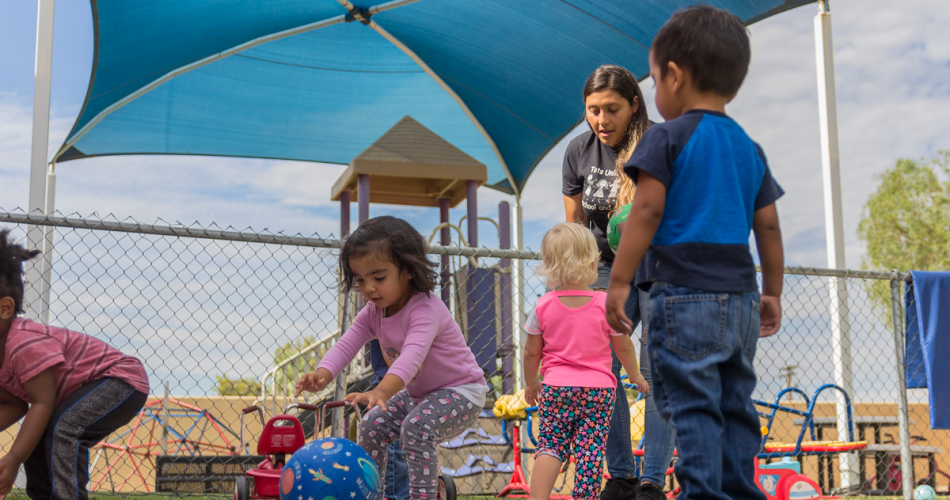As an early childhood educator, you recognize the importance of outdoor physical play on children’s development. At the same time, Arizona’s summer sun can make outdoor play uncomfortable and at times, unsafe. So, how can you provide the active, physical play children need, while keeping them safe during the summer heat?
Here are six tips on keeping children active and safe in the summer time.
1. Modify your schedule for outdoor play
In the heat of summer, you can modify your schedule to allow for plenty of outdoor play during the optimal times of the day. Schedule outdoor play early in the morning (before 10 a.m.) and later in the afternoon (after 4 p.m.) to avoid peak temperatures. Not only does this protect children from becoming overheated during vigorous physical activity, it also protects from harmful ultraviolet (UV) rays that are strongest and most damaging during the middle of the day.
2. Practice sun safety
The Arizona sun gives off intense UV rays, but there are steps you can take to protect children’s skin. Consider the following measures:
- Sunscreen- Encourage families to apply sunscreen before children’s arrival. If you apply sunscreen at your program, be sure to collect written permission from families, keep sunscreen labeled appropriately, and safely stored, so it is not accessible to children. Check bottle(s) regularly to ensure sunscreen hasn’t expired. For more information on using sunscreen in your program, see the Arizona Department of Health Services Child Care Licensing blog on Safe Sunscreen Use.
- Shade- Provide shaded areas for outdoor play. Staying in shaded areas is especially important during the most intense sun of the day (between 10 a.m. to 4 p.m.).
- Hats and sunglasses- A hat provides additional shade, and sunglasses provide important protection to children’s developing eyes, protecting against cataracts later in life. You can ask families to provide a hat and sunglasses to keep at school—or your program may provide these items as part of a child’s enrollment. Make it routine by storing items in children’s cubbies so they are easy to access when it’s time to go outside.
For more sun safety tips, information and resources, visit ADHS’s Empower website.
3. Check your playground for hot surfaces
Certain types of playground equipment and surfacing retain heat and can cause severe burns. This can be avoided by checking the temperatures of surfaces before allowing children to play. If a piece of equipment or surfacing feels hot to your hand, it is too hot for a child’s bare skin. Protect children’s safety by ensuring equipment is covered by shade, and by removing or replacing equipment that retains heat.
4. Keep kids hydrated
On warm days, young children may not recognize their need to drink water while they are busy playing outdoors. You can encourage children to drink more water by keeping drinking water within reach and promoting water breaks at regular intervals during outdoor play. Children will follow your lead if you model good hydration habits, and talk with children about how drinking water makes you feel refreshed and cooled down while playing outdoors.
5. Offer options for active play indoors
Although most days in Arizona allow for outdoor play, certain types of weather call for an alternative. Even in cases of active rainfall, or a weather warning such as an excessive heat warning from the National Weather Service, you can still provide physical activity in your indoor space. If you’re using your classroom space, you may need to rearrange furniture to allow more space to move.
- Dance party – Crank up some music and let loose! Let the children suggest their favorite songs. Play “freeze dance”—pause the music periodically and have everyone “freeze” in place until you start the music again.
- Yoga – Lead children in simple yoga poses and stretches. There are a variety of free online resources including printable yoga picture cards that you can use in your program.
- Obstacle course – Set up an indoor course using everyday items. You can make it as simple or challenging as the children’s abilities dictate- crawling under chairs, balancing on a strip of tape on the floor, tossing a ball into a box, and jumping in and out of a hula-hoop are just a few ideas.
- Movement games – Old fashioned favorites like “Simon Says,” “Red Light, Green Light,” and hopscotch get kids moving and can easily be brought indoors.
6. Use active supervision techniques
During the transitions before and after outdoor play, children can slip away from the group or be left behind in a busy group setting. Consider the following active supervision measures:
- Your roster – keep your roster with you at all times, including during outdoor play. Count and scan frequently to ensure all children are within your supervision.
- Supervision zoning – If you work with another teacher, divide the outdoor space into supervision zones to ensure you can monitor all areas.
- Individualize your supervision – You know the children in your group best, including which children need more supervision. Younger children and children who are more curious or impulsive need an extra close eye to ensure their safety. If you have a child who has difficulty transitioning from outdoor play, give them a job during the transition such as holding the door, helping carry items or leading the line. This helps focus their attention and reduces the chance of them slipping out of view during the busy transition. For more active supervision resources, visit Head Start’s Early Childhood Learning & Knowledge Center.
We hope the tips outlined above are helpful as you work to keep kids active and safe this summer and throughout the year.
At Quality First, we love to hear from you! Let us know how you are keeping children physically active at your program. Send an email to qualityfirst@firstthingsfirst.org.
